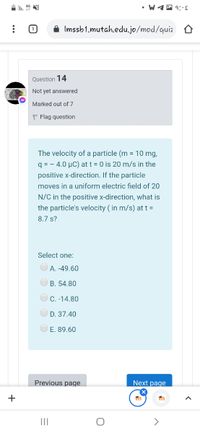Question

Transcribed Image Text:A Imssb1.mutah.edu.jo/mod/quiz
Question 14
Not yet answered
Marked out of 7
P Flag question
The velocity of a particle (m = 10 mg,
q = - 4.0 µC) at t = 0 is 20 m/s in the
positive x-direction. If the particle
moves in a uniform electric field of 20
N/C in the positive x-direction, what is
the particle's velocity ( in m/s) at t =
8.7 s?
Select one:
A. -49.60
B. 54.80
C. -14.80
D. 37.40
E. 89.60
Previous page
Next page
+
II
Expert Solution
This question has been solved!
Explore an expertly crafted, step-by-step solution for a thorough understanding of key concepts.
This is a popular solution
Trending nowThis is a popular solution!
Step by stepSolved in 2 steps with 1 images

Knowledge Booster
Similar questions
- An electron is moving with a velocity, v = (0.000i, 6.95x10²j, 0.00k)m/s, when it enters a region of uniform electric field E=(6.40i, 0.00j, 0.00k) N/C. mẹ = 9.11x10-3!kg, qe= -1.60x10-1ºC a. What is the acceleration of the electron while it is in the region with the electric field? b. How far has the electron moved in the z direction after traveling 5.00cm in the +y direction?arrow_forwardA particle of charge q=3.0 uC and mass m=2.0 mg enters a region of a uniform electric field as shown in the figure, with vj = 3.00 x 10° m/s, E = 222 N/C, and b = 0.100 m. Find the magnitude of the acceleration (in m/s2) of the particle while it is in the electric field. (0, 0) 07:48P 31°Carrow_forwardA proton has a mass of about 1.673x10-27kg. If an electron is placed in a region of space within which a constant electric field exists with magnitude 4.156 N/C, how long would it take this proton to travel a distance of 649.72m in units of ms (milliseconds)? Assume the proton does not collide with anything along the way. Hint: You will need to use the kinematic relationships for linear motion that we learned back in PHY 2010. This results of this problem show you that small charges like protons, and electrons too, move great distances in a short amount of time under very small external electric fields - if those charges are in a vacuum - otherwise, they quickly strike a nearby charge.arrow_forward
- A proton has a mass of about 1.673x10-27kg. If an electron is placed in a region of space within which a constant electric field exists with magnitude 4.878 N/C, how long would it take this proton to travel a distance of 218.64m in units of ms (milliseconds)? Assume the proton does not collide with anything along the way. Hint: You will need to use the kinematic relationships for linear motion that we learned back in PHY 2010. This results of this problem show you that small charges like protons, and electrons too, move great distances in a short amount of time under very small external electric fields - if those charges are in a vacuum - otherwise, they quickly strike a nearby charge. Note: It is understood that the unit of your answer is in milliseconds, however do not explicitly include units in your answer. Enter only a number.arrow_forwardWhat are the magnitude and direction of the acceleration of an electron at a point where the electric field has magnitude 8651 N/C and is directed due north?arrow_forwardAn electron is initially moving horizontally at v0 = 3x10-6 m/s when it enters a uniform electric field of 5.6 N/C directed virtually down. What are the horizontal and vertical components of its velocity 2 μs after entering the electric field?arrow_forward
- A proton is projected in the positive x direction into a region of a uniform electric field E= -3.00 * 10° i N/C at t = 0. The proton travels 6.00 cm before coming to rest. Determine its initial speed? (proton mass 1.6 * 1027 kg)arrow_forwardHelp with C?arrow_forwardInside a vacuum tube, an electron is in the presence of a uniform electric field with a magnitude of 320 N/C. (a) What is the magnitude of the acceleration of the electron (in m/s2)? (b) The electron is initially at rest. What is its speed (in m/s) after 1.10 ✕ 10−8 s?arrow_forward
- An electron enters a region of uniform electric field with an initial velocity of 58 km/s in the same direction as the electric field, which has magnitude E = 53 N/C. (a) What is the speed of the electron 1.4 ns after entering this region? (b) How far does the electron travel during the 1.4 ns interval?arrow_forwardInside a cathode ray tube, an electron is in the presence of a uniform electric field with a magnitude of 325 N/C. (a) What is the magnitude of the acceleration of the electron (in m/s²)? m/s² (b) The electron is initially at rest. What is its speed (in m/s) after 1.05 x 10-8 s? m/sarrow_forwardAn alpha particle (a helium nucleus) is traveling along the positive x-axis at 1200 m/s when it enters a cylindrical tube of radius 0.400 cm centered on the x-axis. Inside the tube is a uniform electric field of 5.50 10-4 N/C pointing in the negative y-direction. How far does the particle travel before hitting the tube wall? Neglect any gravitational forces. Note: m? = 6.64 10-27 kg; q? = 2e. marrow_forward
arrow_back_ios
SEE MORE QUESTIONS
arrow_forward_ios